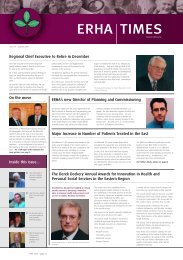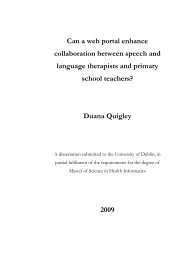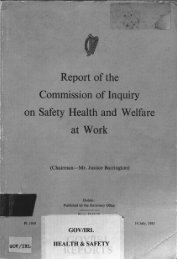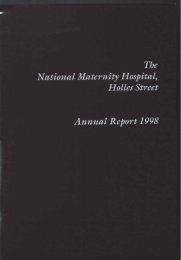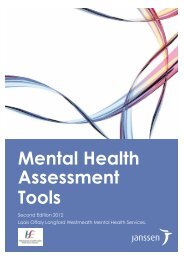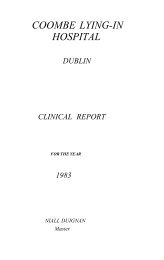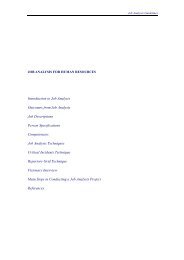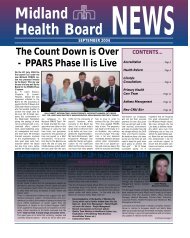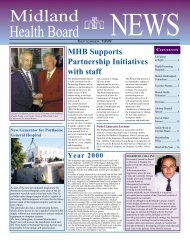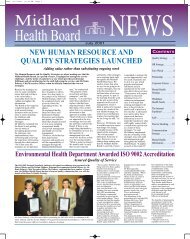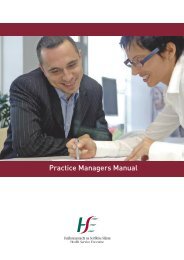pport ur baby - Irish Health Repository
pport ur baby - Irish Health Repository
pport ur baby - Irish Health Repository
You also want an ePaper? Increase the reach of your titles
YUMPU automatically turns print PDFs into web optimized ePapers that Google loves.
Post natal<br />
depression<br />
– role of the<br />
practice n<strong>ur</strong>se<br />
Approximately 13% of mothers experience<br />
PND. It occ<strong>ur</strong>s at a crucial time in a mother’s<br />
life, can persist for long periods and have<br />
adverse effects on partners and on the<br />
emotional and cognitive development of<br />
the child.<br />
DR PATRIcIA leAhy-wARReN, RGN, RM,<br />
BSC(NuRS), DIPCoM, DIPMGT, HDIPPHN,<br />
MSC(NuRS), PHD, SENIoR LECTuRER,<br />
NuRSING AND MIDWIFERY, uCC.<br />
Postnatal depression (PND) is a significant public health<br />
issue, occ<strong>ur</strong>ring d<strong>ur</strong>ing the perinatal period which is a<br />
time of intense change and transition for women. Detection<br />
of and intervention in PND is crucial to the wellbeing<br />
of mothers, their infants, partners and families.<br />
Becoming a mother is a significant developmental transition,<br />
and a woman’s adaptiveness involves her biopsychosocial<br />
being, family and the society in which she lives. First-time<br />
mothers are faced with the demands of learning new skills<br />
relating to infant care practices and recovering physically<br />
and emotionally from child birth. This transition is a process<br />
of personal and interpersonal change as a woman assumes<br />
maternal tasks and appraises herself as a mother. 1 D<strong>ur</strong>ing this<br />
transitional period, mothers are presented with the challenge<br />
of simultaneously providing self-care and infant care while in<br />
the hospital and then mastering these skills at home, often in<br />
an unsu<strong>pport</strong>ed environment.<br />
The focus of this paper is to present a discussion on issues<br />
related to PND. The concept of PND is discussed in the context<br />
of prevalence and definition which is followed by an outline<br />
of the symptoms experienced by mothers. Identification and<br />
screening of PND is a crucial step in dealing with this significant<br />
problem for new mothers and is considered together with the<br />
NICE guidelines. Finally, the treatments for PND are outlined.<br />
<strong>Irish</strong> research on social su<strong>pport</strong> and first-time mothers is<br />
discussed in relation to their mental health and well-being.<br />
concept of PND<br />
Ascertaining the combined period prevalence of PND and<br />
minor depressive disorders is estimated to be between 5%<br />
clinical review<br />
and 25%. This wide variation in prevalence rates indicates<br />
inherent difficulty in estimating them and is at least partly<br />
due to the many ways in which it is defined. The World <strong>Health</strong><br />
organisation and the American Psychiatric Association define<br />
it as being similar to general depression with the exception<br />
of the timescale, which is limited to 4-6 weeks postpartum.<br />
Several longitudinal and epidemiological studies have yielded<br />
varying prevalence rates, however a meta-analysis of 59 studies<br />
reported a prevalence of 13%, with most cases starting in the<br />
first three months postpartum. 2 Internationally, prevalence<br />
rates vary across and within countries, ranging from as low<br />
as 4.4% at 12 months to as high as 73.7%. 3 Prevalence rates<br />
reported from Ireland have also varied from 11.4% to 28.6%<br />
4 with the most recent study reporting prevalence rates of<br />
13% at 6 weeks and 10% at 12 weeks. 5 There may be many<br />
reasons for this variation which include: using different<br />
screening assessments, using varying cut-off scores (11-13) on<br />
the Edinb<strong>ur</strong>gh Postnatal Depression Scale (EPDS), 6 assorted<br />
timescales (6-12 weeks postpartum) and different samples.<br />
For example one study included a high representation of a<br />
sample of mothers with a previous history of depression. 7<br />
This morbidity has well documented health consequences<br />
for the mother, child, and family. Women who have PND are<br />
significantly more likely to experience fut<strong>ur</strong>e episodes of<br />
depression and infants and children are particularly vulnerable<br />
because of impaired maternal-infant interactions and<br />
significant cognitive and emotional development. 8 The nat<strong>ur</strong>e<br />
and symptoms of postnatal depression are characterised<br />
by tearfulness, fatigue, anxiety, despondency and excessive<br />
anxiety over the <strong>baby</strong>. 6<br />
25
clinical review<br />
26<br />
Triggers or events<br />
• Having a <strong>baby</strong><br />
• Accident<br />
• Bereavement<br />
• Marital breakdown<br />
• Moving house<br />
• Illness<br />
• Traumatic experience<br />
Always seeing<br />
the dark side<br />
Not living up<br />
to one self<br />
fig<strong>ur</strong>e 1. bio Psychosocial explanations of Depression<br />
Cited from Nicolson, P (1988) Postnatal Depression Facing the paradox of loss, happiness and motherhood p. 13 Wiley, Sussex.<br />
causes and symptoms<br />
The cause of postnatal depression remains unclear; however,<br />
extensive research suggests many contributory factors.<br />
The importance of psychosocial, psychopathology and<br />
psychological risk factors have consistently been identified in<br />
the epidemiological studies and meta-analyses conducted.<br />
The strongest predictors include: past history of psychological<br />
dist<strong>ur</strong>bance, stress, marital conflict, low maternal self-efficacy<br />
(confidence) and poor social su<strong>pport</strong>. In addition, indicators<br />
of low social status showed a small but significant predictive<br />
relation to PND. 2, 9 The bio-psychosocial model outlined in<br />
Fig<strong>ur</strong>e1 demonstrates the complexity of depression and hence<br />
the difficulties in identifying the cause. 10 Identification of PND<br />
for postnatal mothers is essential both for the mother and for<br />
her infant’s health and wellbeing. Therefore, it is necessary for<br />
healthcare professionals to recognise and acknowledge the<br />
experiences of mothers with PND.<br />
A number of qualitative studies have been undertaken<br />
internationally to gain a greater and deeper understanding of<br />
11, 12, 13, 14,<br />
what the experiences are from mothers’ perspectives.<br />
15,16 These studies depict the following feelings and experiences<br />
Practice n<strong>ur</strong>ses can<br />
contribute by fostering<br />
emotional su<strong>pport</strong> from<br />
significant others within<br />
mothers’ social network.<br />
history of<br />
depression or<br />
other mental<br />
health problems<br />
history of physical<br />
or sexual abuse<br />
vulnerability or Risk<br />
factors<br />
• Social isolation<br />
• Domestic abuse<br />
• Low self-esteem/efficacy<br />
• Physical ill health or<br />
exhaustion<br />
Denial or refusal to<br />
face up to issues<br />
high expectations<br />
about being able to<br />
cope regardless<br />
of mothers with postnatal depression: loneliness, hopelessness,<br />
anxiety, confusion, poor concentration, guilt and fatigue. From<br />
an empirical perspective mothers’ descriptions of PND also<br />
include elements of loss such as, loss of control or loss of former<br />
identity. Consequently PND differs from general depression,<br />
not only in timeframe, but also in the context of role transition,<br />
including loss of familiarity and thus, loss of control and<br />
the need to feel normal. This rich data provides us with an<br />
understanding of what it is like for mothers living with PND.<br />
Practice n<strong>ur</strong>ses will meet mothers and their new infant,<br />
frequently accompanied by their partner, when they attend<br />
their GP for the 2 week <strong>baby</strong> check-up. This first visit to the<br />
GP is an ideal o<strong>pport</strong>unity to assess the mother’s physical and<br />
psychological health and well-being.<br />
Risk identification<br />
Identifying women at risk for pos PND and providing early<br />
treatment interventions are the first steps in dealing with this<br />
problem. Although a number of tools (essentially self-report<br />
questionnaires) have been developed for the detection of<br />
depression, only eight studies assess their use in the postnatal<br />
period. only one of these, the Edinb<strong>ur</strong>gh Post Depression<br />
Scale, 6 has been used in a sufficient number of studies to<br />
make a judgement on its usefulness. However, these studies<br />
have a number of limitations including: small sample size,<br />
high prevalence of depression amongst the included studies<br />
and many were undertaken in a research rather than a clinical<br />
setting. There has been much debate in the literat<strong>ur</strong>e as to the<br />
suitability of using the EPDS in clinical practice for screening<br />
for PND. This reluctance is primarily related to the EPDS having<br />
reasonable sensitivity but lower specificity and thus positive<br />
predictive value is poor. This means that many women who do<br />
not have PND are being told of the possibility that they have<br />
the condition and are then subject to f<strong>ur</strong>ther investigation,<br />
placing an increased and wasteful b<strong>ur</strong>den on reso<strong>ur</strong>ces.<br />
Similarly, the two Whooley 17 questions plus the additional
AF=atrial fibrillation.<br />
NEW<br />
Stroke devastates.<br />
Xarelto protects.<br />
Simplifying protection with<br />
no coagulation monitoring 1<br />
One-Tablet, Once-Daily Xarelto ®<br />
for Stroke Prevention in AF 1<br />
O<br />
PROVEN<br />
EFFICACY<br />
ADDED<br />
PROTECTION<br />
Highly effective, first<br />
oral Factor Xa inhibitor 1,2<br />
ONCE<br />
DAILY<br />
Lower rates of intracranial<br />
haemorrhage and<br />
fatal bleeds than warfarin 1,2<br />
One tablet, once daily:<br />
adding simplicity<br />
to prevention 1<br />
Xarelto 15mg and 20mg film-coated tablets (Rivaroxaban).<br />
Please refer to full SmPC before prescribing. Presentation: Film-coated tablet containing 15mg or 20mg of rivaroxaban. Indication: Prevention of stroke and systemic embolism in adult patients with non-valvular atrial<br />
fibrillation with one or more risk factors, such as congestive heart fail<strong>ur</strong>e, hypertension, age ≥ 75 years, diabetes mellitus, prior stroke or transient ischaemic attack. Treatment of deep vein thrombosis (DVT) and prevention of<br />
rec<strong>ur</strong>rent DVT and pulmonary embolism (PE) following an acute DVT in adults. Dosage and Administration: Prevention of stroke and systemic embolism: The recommended dose is 20 mg once daily, which is also the<br />
recommended maximum dose. Treatment of DVT and prevention of rec<strong>ur</strong>rent DVT and PE: The recommended dose for the initial treatment of acute DVT is 15 mg twice daily for the first three weeks followed by 20 mg once daily<br />
for the continued treatment and prevention of rec<strong>ur</strong>rent DVT and PE. Renal impairment: No dose adjustment is necessary in patients with mild renal impairment. Patients with moderate or severe renal impairment, for the<br />
prevention of stroke and systemic embolism in patients with non-valvular atrial fibrillation, the recommended dose is 15mg once daily, and for the treatment of DVT and prevention of rec<strong>ur</strong>rent DVT and PE, treatment should<br />
be 15mg twice daily for the first 3 weeks, thereafter the recommended dose is 15mg once daily. Hepatic impairment: Contraindicated in patients with hepatic disease associated with coagulopathy and clinically relevant bleeding<br />
risk including cirrhotic patients with Child Pugh B and C. Contraindications: Hypersensitivity to the active substance or any of the excipients; clinically significant active bleeding; hepatic disease associated with coagulopathy<br />
and clinically relevant bleeding risk including cirrhotic patients with Child Pugh B and C hepatic impairment; pregnancy and breast feeding. Warnings and Precautions: Not recommended: in patients receiving concomitant<br />
systemic treatment with strong conc<strong>ur</strong>rent CYP3A4- and P-gp-inhibitors, i.e. azole-antimycotics or HIV protease inhibitors; in patients with severe renal impairment (creatinine clearance
clinical review<br />
28<br />
The nat<strong>ur</strong>e and<br />
symptoms of postnatal<br />
depression are<br />
characterised by<br />
tearfulness, fatigue,<br />
anxiety, despondency<br />
and excessive anxiety<br />
over the <strong>baby</strong><br />
Arroll question (Table 1) have poor positive predictive value.<br />
Nonetheless, the C<strong>ur</strong>rent NICE guidelines 18 recommend using<br />
them. Although little specific evidence exists for their use in the<br />
perinatal period, their ease of use and reasonable sensitivity<br />
and specificity, particularly if combined with the additional<br />
help question from Arroll et al. 19 suggest that their use in<br />
routine care may be practical and acceptable. The questions<br />
(Table 1) are simple screening methods which can detect<br />
postnatal depression and lead to a subsequent referral for a<br />
full clinical assessment follow-up. This screening technique is<br />
an o<strong>pport</strong>unity to screen without the need for a more formal<br />
assessment. Practice n<strong>ur</strong>ses and public health n<strong>ur</strong>ses have<br />
the most contact with mothers in the postpartum period and<br />
therefore are in a prime position to assess for PND and provide<br />
su<strong>pport</strong>.<br />
Table 1 The whooley questions<br />
Treatment<br />
Treatments for PND are variable depending on the<br />
severity and a mother’s preferences. Treatments include<br />
antidepressants, psychotherapy, su<strong>pport</strong>, or a combination<br />
of these. Evidence-based treatments include antidepressants<br />
cognitive behavio<strong>ur</strong>al counselling (CBC), cognitive behavio<strong>ur</strong><br />
therapy (CBT), psychodynamic therapy and su<strong>pport</strong>ive<br />
counselling either in the home, as a member of a group<br />
or telephone contact. 4 Combined approaches involving<br />
psychopharmacology and psychotherapy using a holistic<br />
approach with mothers in the context of the broader sociopolitical<br />
climate have been demonstrated as effective. 4 Social<br />
su<strong>pport</strong> has also been identified in a number of studies to<br />
contribute positively to the transition to motherhood and more<br />
specifically to postnatal depression.<br />
Social su<strong>pport</strong><br />
International and national policy documents suggest that<br />
su<strong>pport</strong> is necessary for maternal and infant well-being and<br />
facilitates women’s adaptation to motherhood. In previous<br />
research, mothers in the postnatal period have reported that<br />
help received from their partners and mothers, both with<br />
household chores and infant care, to be of great importance to<br />
them. Providing su<strong>pport</strong> for mothers in caring for their infants<br />
in the postnatal period is an important concern for n<strong>ur</strong>ses<br />
in the community, because research has shown that social<br />
su<strong>pport</strong> can facilitate women’s transition to motherhood. 20<br />
F<strong>ur</strong>thermore, previous research has indicated that social<br />
su<strong>pport</strong> from partners, maternal mothers and peers, 21 and<br />
home visits from n<strong>ur</strong>ses 22 have reduced postnatal depressive<br />
symptoms.<br />
Within the <strong>Irish</strong> context, given the importance of social<br />
su<strong>pport</strong> in facilitating transition to motherhood, Leahy-<br />
Warren 23 conducted research with first-time mothers (n=99)<br />
exploring the relationship between social su<strong>pport</strong> and<br />
confidence in infant care practices at 6 weeks postpartum.<br />
Findings revealed that su<strong>pport</strong> in the guise of mothers’<br />
receiving positive affirmation with caring for their infant had<br />
a significant influence in their confidence. Mothers revealed<br />
that the so<strong>ur</strong>ces of this type of su<strong>pport</strong> were their partner and<br />
As per the NICE guidelines (2007) – at a woman’s first contact with primary care, both at her booking visit and first visit<br />
postnatally, healthcare professionals including n<strong>ur</strong>ses, midwives, public health n<strong>ur</strong>ses or GPs should ask two questions<br />
to identify possible depression. The Whooley questions are derived from research (Whooley, Avins, Miranda, 1997) which<br />
indicate that directed questions are as sensitive in case finding for postnatal depression as more detailed techniques.<br />
The questions are:<br />
1. ‘D<strong>ur</strong>ing the last month, have you often been bothered by feeling down, depressed or hopeless?’<br />
2. ‘D<strong>ur</strong>ing the last month have you often been bothered by having little interest or pleas<strong>ur</strong>e in doing things?’<br />
(NICE CG 45)<br />
This is also supplemented with a third question if the answer to either of the first two is ‘Yes’:<br />
3. ‘Is this something with which you would like help?’ which has three possible responses:<br />
‘No,’ ‘Yes, but not today,’ and ‘Yes.’<br />
(Arroll, Goodyear-Smith, Kerse, N., et al.2005).<br />
References<br />
Arroll, B., Goodyear-Smith, F., Kerse, N., et al. (2005) Effect of the addition of a ‘help’ question to two screening questions on specificity for<br />
diagnosis of depression in general practice: diagnostic validity study. British Medical Jo<strong>ur</strong>nal, vol 331, p 884<br />
National Institute for <strong>Health</strong> and Clinical Excellence (2007) Antenatal and postnatal mental health: clinical management and service<br />
guidance (NICE CG 45) (para 5.4.3 p116).<br />
Whooley, M. A., Avins, A. L., Miranda, J., et al. (1997) Case-finding instruments for depression. Two questions are as good as many. Jo<strong>ur</strong>nal of<br />
General Internal Medicine, vol 12, pp 439–445
mother. Results also showed that public health n<strong>ur</strong>ses and their<br />
own mother were the primary so<strong>ur</strong>ce of informational su<strong>pport</strong>.<br />
Therefore, it is essential that n<strong>ur</strong>ses facilitate the identification<br />
of individual mother’s so<strong>ur</strong>ces of su<strong>pport</strong> and continue to<br />
provide them with information that is relevant and appropriate.<br />
A more recent <strong>Irish</strong> study examined the relationship<br />
between postnatal depression, maternal parental self-efficacy<br />
(confidence) and postnatal depression d<strong>ur</strong>ing the first 3<br />
months postpartum with a large sample of first-time mothers<br />
(n= 512). 5, 24 The results showed that at 6 weeks, significant<br />
relationships were found between functional social su<strong>pport</strong><br />
and PND and informal social su<strong>pport</strong> and PND. This means<br />
that su<strong>pport</strong> received from a mother’s partner, own mother,<br />
family and friends positively influenced pos PND symptoms<br />
at 6 weeks. The types of su<strong>pport</strong>s that were significant were<br />
informational, instrumental (hands-on help), emotional (caring)<br />
and appraisal (positive affirmation). Findings also revealed<br />
that the higher the level of maternal/parental self-efficacy<br />
(confidence) the lower the level of depressive symptoms. This<br />
means that mothers who have confidence in their own ability<br />
to care for their infants are less likely to have PND symptoms.<br />
N<strong>ur</strong>ses need to be aware of and acknowledge the significant<br />
contribution of social su<strong>pport</strong>, particularly from family and<br />
friends in positively influencing the mental health and wellbeing<br />
of first-time mothers.<br />
The best predictors of PND at 12 weeks were at-birth<br />
professional su<strong>pport</strong> and emotional su<strong>pport</strong>. What this means<br />
is that mothers who received low levels of professional su<strong>pport</strong><br />
at birth were 3.24 times more at risk of PND at 12 weeks than<br />
mothers who received high levels. F<strong>ur</strong>thermore, there was an<br />
elevated risk (2.92 times) of PND at 12 weeks in mothers with<br />
low emotional su<strong>pport</strong>, compared with those who received<br />
high emotional su<strong>pport</strong> at birth. 5, 24 These findings signify the<br />
need for n<strong>ur</strong>ses to be mindful of the importance of su<strong>pport</strong>ing<br />
mothers in the early postnatal period. Practice n<strong>ur</strong>ses can<br />
contribute by fostering emotional su<strong>pport</strong> from significant<br />
others within mothers’ social network.<br />
conclusion<br />
Postnatal depression is a serious public health issue and<br />
can have devastating consequences for mothers, partners,<br />
infants and their families. Early identification and appropriate<br />
intervention is crucial in dealing with this condition and<br />
practice n<strong>ur</strong>ses are in an ideal position to facilitate this.<br />
F<strong>ur</strong>thermore, n<strong>ur</strong>ses are well placed to mobilise social su<strong>pport</strong><br />
for new mothers and enco<strong>ur</strong>age their partners and mothers to<br />
provide all types of su<strong>pport</strong> throughout pregnancy, delivery<br />
and the postpartum period.<br />
References<br />
1. Mercer, R. (2004). Becoming a Mother versus Maternal Role<br />
Attainment. Jo<strong>ur</strong>nal of N<strong>ur</strong>sing Scholarship 36(3): 226-232<br />
2. o’ Hara, M. and A. Swain (1996). Rates and risk of<br />
postpartum depression-a meta-analysis. International<br />
Review of Psychiatry 8: 37-54.<br />
3. Affonso, D., K. Anindya, et al. (2000). An international study<br />
exploring levels of postpartum depressive symptomatology.<br />
Jo<strong>ur</strong>nal of Psychosomatic Disorder (49): 207-216.<br />
4. Leahy-Warren, P. and G. McCarthy (2007). Postnatal<br />
depression: Prevalence, Mothers’ perspectives, and<br />
treatments. Archives of Psychiatric N<strong>ur</strong>sing 21(2): 91-100.<br />
5. Leahy-Warren, P., G. McCarthy, et al. (2011). First-Time<br />
Mothers: Social Su<strong>pport</strong>, Maternal Parental Self-Efficacy<br />
clinical review<br />
and Postnatal Depression. Jo<strong>ur</strong>nal of Clinical N<strong>ur</strong>sing DoI:<br />
10.1111/j.1365-2702.2011.03701.x<br />
6. Cox, J., J. Holden, et al. (1987). Detection of postnatal<br />
depression – development of the 10-item. Edinb<strong>ur</strong>gh<br />
Postnatal Depression scale. British Jo<strong>ur</strong>nal of Psychiatry 150:<br />
782-786.<br />
7. Cryan, E., F. Keogh, et al. (2001). Depression among<br />
postnatal women in an <strong>ur</strong>ban <strong>Irish</strong> community. <strong>Irish</strong> Jo<strong>ur</strong>nal<br />
of Psychology Medicine 18(1): 5-10.<br />
8. Beck, C. (1998). A review of research instruments for<br />
use d<strong>ur</strong>ing the postpartum period. American Jo<strong>ur</strong>nal of<br />
Maternal Child N<strong>ur</strong>sing 23(5): 254-261.<br />
9. Beck, C. T. (2001). Predictors of Postpartum Depression: An<br />
update. N<strong>ur</strong>sing Research. 50(5):275-285.<br />
10. Nicolson, P (1988) Postnatal depression facing the paradox<br />
of loss, happiness and motherhood. p13 Sussex: Wiley<br />
11. Nicolson, P. (1990). understanding postnatal depression: a<br />
mother-centred approach. Jo<strong>ur</strong>nal of Advanced N<strong>ur</strong>sing 15:<br />
689-695.<br />
12. Beck, C. (1992). The lived experience of postpartum<br />
depression: a phenomenological study. N<strong>ur</strong>sing Research<br />
41(3): 166-170.<br />
13. Beck, C. (1993). Teetering on the edge: a substantive theory<br />
of postpartum depression. N<strong>ur</strong>sing Research. 42(1): 42-48.<br />
14. Chan, S. and V. Levy (2004). Postnatal depression: a<br />
qualitative study of the experiences of a group of Hong<br />
Kong Chinese women. Jo<strong>ur</strong>nal of Clinical N<strong>ur</strong>sing 13: 120-<br />
123.<br />
15. ugarriza, D. N. (2002). Postpartum Depressed Women’s<br />
Explanation of Depression. Jo<strong>ur</strong>nal of N<strong>ur</strong>sing Scholarship<br />
34(3): 227-233.<br />
16. Scrandis, D. A. (2005). Normalizing Postpartum Depressive<br />
Symptoms With Social Su<strong>pport</strong>. Jo<strong>ur</strong>nal of the American<br />
Psychiatric N<strong>ur</strong>ses Association 11: 223-230.<br />
17. Whooley, M. A., Avins, A. L., Miranda, J., et al. (1997) Casefinding<br />
instruments for depression. Two questions are as<br />
good as many. Jo<strong>ur</strong>nal of General Internal Medicine, (12),<br />
439–445<br />
18. National Institute for <strong>Health</strong> and Clinical Excellence<br />
(2007) Antenatal and postnatal mental health: clinical<br />
management and service guidance (NICE CG 45) (para 5.4.3<br />
p116).<br />
19. Arroll, B., Goodyear-Smith, F., Kerse, N., et al. (2005) Effect of<br />
the addition of a ‘help’ question to two screening questions<br />
on specificity for diagnosis of depression in general practice:<br />
diagnostic validity study. BMJ, (331), 884.<br />
20. Wilkins, C. ( 2006) A qualitative study exploring the su<strong>pport</strong><br />
needs of first-time mothers on theirjo<strong>ur</strong>ney towards<br />
intuitive parenting Midwifery 22(2), 169-180.<br />
21. Dennis, C. (2003). The Effect of Peer Su<strong>pport</strong> on Postpartum<br />
Depression: A Pilot Randomized Controlled Trial. Canadian<br />
Jo<strong>ur</strong>nal of Psychiatry 48(2): 115-124.<br />
22. Shaw, E., C. Levitt, et al. (2006). Systematic Review of the<br />
Literat<strong>ur</strong>e on Postpartum Care: Effectiveness of Postpartum<br />
Su<strong>pport</strong> to Improve Maternal Parenting, Mental <strong>Health</strong>,<br />
Quality of Life, and Physical <strong>Health</strong> Birth 33(3): 210-220.<br />
23. Leahy-Warren, P. (2005) First-time mothers: social su<strong>pport</strong><br />
and confidence in infant care Jo<strong>ur</strong>nal of Advanced N<strong>ur</strong>sing<br />
50: 479-488.<br />
24. Leahy-Warren, P., McCarthy. G., Corcoran, P. (2010).<br />
Postnatal Depression in First-Time Mothers: Prevalence<br />
and Relationships between Functional and Struct<strong>ur</strong>al<br />
Social Su<strong>pport</strong> at 6 and 12 Weeks Postpartum. Archives of<br />
Psychiatric N<strong>ur</strong>sing. doi:10.1016/j.apnu.2010.08.005.<br />
29




